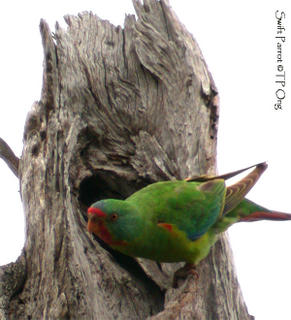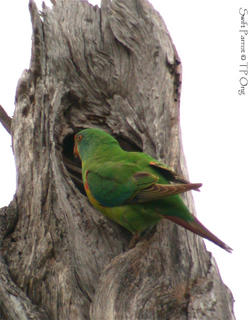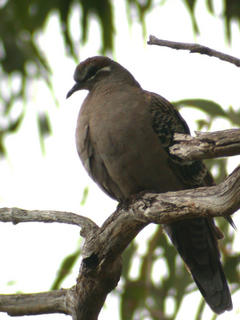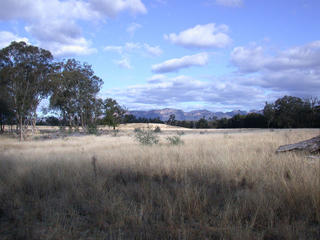 Typical scenary in Capertee Valley - farmland with sparse trees which serve as critical habitat for Regent Honeyeater.
Typical scenary in Capertee Valley - farmland with sparse trees which serve as critical habitat for Regent Honeyeater.Regent Honeyeater (Xanthomyza phrygia)

On 21 Aug 2005, I travelled to Capertee Valley for the 3rd time, to look for my favorate target - Regent Honeyeater and possibly the Swift Parrot. As it turned out that I managed to see the Swift Parrot since my last unexpected sighting at Blue Mountains 5 years ago with the help of Allan Richards.
In my previous trip last month, I had suspected some breeding activities had begun for the Regent Honeyeater. This time I was right that I was very lucky to locate an active nest. The nest was built on a tip of a casuarina branch, making the branch look rounded at the end. Both the parents took turn to feed and brood the nest. The chick(s) was too young and small to be seen from the nest at the moment.
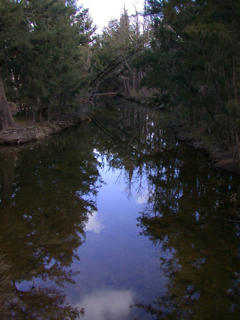 The Regent Honeyeater had become very skittish this time and hence it was very difficult to take any photograph of the ever moving honeyeater. I guess the parents were busy collecting food for its chicks and also there were presence of Noisy Friarbird in the territory, an aggressive competitor. I only managed to get one shot in very poor lighting as shown above.
The Regent Honeyeater had become very skittish this time and hence it was very difficult to take any photograph of the ever moving honeyeater. I guess the parents were busy collecting food for its chicks and also there were presence of Noisy Friarbird in the territory, an aggressive competitor. I only managed to get one shot in very poor lighting as shown above.
This trip to Capertee had coincided with the Tree Planting weekend - a conservation effort participated by conservationists, birdwatchers and volunteers to create more suitable habitat for the endangered Regent Honeyeater. There I bumped into a number of birders and volunteers who took part in the tree planting including David Geering and Carol Probet, whom I had met for the first time but had contacted through emails recently.
I hope I could be of any help or some sort of contribution by showing the active nest of Regent Honeyeater through my spotting scope to the volunteers and their families.
One of the preferred habitats of Regent Honeyeater, the Riparian (Riverbank) Woodland
------------------------------------------------------------------------------------------------------------------------------------
IMPORTANT REMINDER:
.
Despite being a very excellent birding site, Capertee Valley is NOT a nature reserve or national park. It is mostly of farmland setting with fragmented woolands consisting of White Box. Many private properties have been converted to secluded residence. There are many 'No Trepassing' signboards are put up on the gates. Some properties even keep guard dogs.
.
There are also a number of properties that provide accommodations to visitors. Some of these properties have good habitat for birds but are not accessible to outsiders.
.
It is during this particular good season that birders are able to see many birds by simply scanning through trees beside the road. Look out particularly for blossoming White Box.
.
Beware of passing vehicles too when birdwatching along the country road. Although the country road is very quiet, most vehicles run at 60km/h onwards.
 Typical scenary in Capertee Valley - farmland with sparse trees which serve as critical habitat for Regent Honeyeater.
Typical scenary in Capertee Valley - farmland with sparse trees which serve as critical habitat for Regent Honeyeater. The Regent Honeyeater had become very skittish this time and hence it was very difficult to take any photograph of the ever moving honeyeater. I guess the parents were busy collecting food for its chicks and also there were presence of Noisy Friarbird in the territory, an aggressive competitor. I only managed to get one shot in very poor lighting as shown above.
The Regent Honeyeater had become very skittish this time and hence it was very difficult to take any photograph of the ever moving honeyeater. I guess the parents were busy collecting food for its chicks and also there were presence of Noisy Friarbird in the territory, an aggressive competitor. I only managed to get one shot in very poor lighting as shown above.

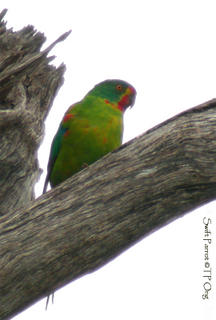
 'FORKED TAIL' PARROT
'FORKED TAIL' PARROT
